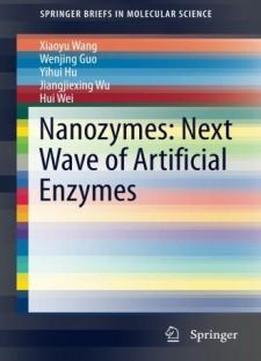
Nanozymes: Next Wave Of Artificial Enzymes (springerbriefs In Molecular Science)
by Xiaoyu Wang /
2016 / English / PDF
4.4 MB Download
This book describes the fundamental concepts, the latest
developments and the outlook of the field of nanozymes (i.e., the
catalytic nanomaterials with enzymatic characteristics). As one of
today’s most exciting fields, nanozyme research lies at the
interface of chemistry, biology, materials science and
nanotechnology. Each of the book’s six chapters explores advances
in nanozymes. Following an introduction to the rise of nanozymes
research in the course of research on natural enzymes and
artificial enzymes in Chapter 1, Chapters 2 through 5 discuss
different nanomaterials used to mimic various natural enzymes, from
carbon-based and metal-based nanomaterials to metal oxide-based
nanomaterials and other nanomaterials. In each of these chapters,
the nanomaterials’ enzyme mimetic activities, catalytic mechanisms
and key applications are covered. In closing, Chapter 6 addresses
the current challenges and outlines further directions for
nanozymes. Presenting extensive information on nanozymes and
supplemented with a wealth of color illustrations and tables, the
book offers an ideal guide for readers from disparate areas,
including analytical chemistry, materials science, nanoscience and
nanotechnology, biomedical and clinical engineering, environmental
science and engineering, green chemistry, and novel catalysis.
This book describes the fundamental concepts, the latest
developments and the outlook of the field of nanozymes (i.e., the
catalytic nanomaterials with enzymatic characteristics). As one of
today’s most exciting fields, nanozyme research lies at the
interface of chemistry, biology, materials science and
nanotechnology. Each of the book’s six chapters explores advances
in nanozymes. Following an introduction to the rise of nanozymes
research in the course of research on natural enzymes and
artificial enzymes in Chapter 1, Chapters 2 through 5 discuss
different nanomaterials used to mimic various natural enzymes, from
carbon-based and metal-based nanomaterials to metal oxide-based
nanomaterials and other nanomaterials. In each of these chapters,
the nanomaterials’ enzyme mimetic activities, catalytic mechanisms
and key applications are covered. In closing, Chapter 6 addresses
the current challenges and outlines further directions for
nanozymes. Presenting extensive information on nanozymes and
supplemented with a wealth of color illustrations and tables, the
book offers an ideal guide for readers from disparate areas,
including analytical chemistry, materials science, nanoscience and
nanotechnology, biomedical and clinical engineering, environmental
science and engineering, green chemistry, and novel catalysis.











